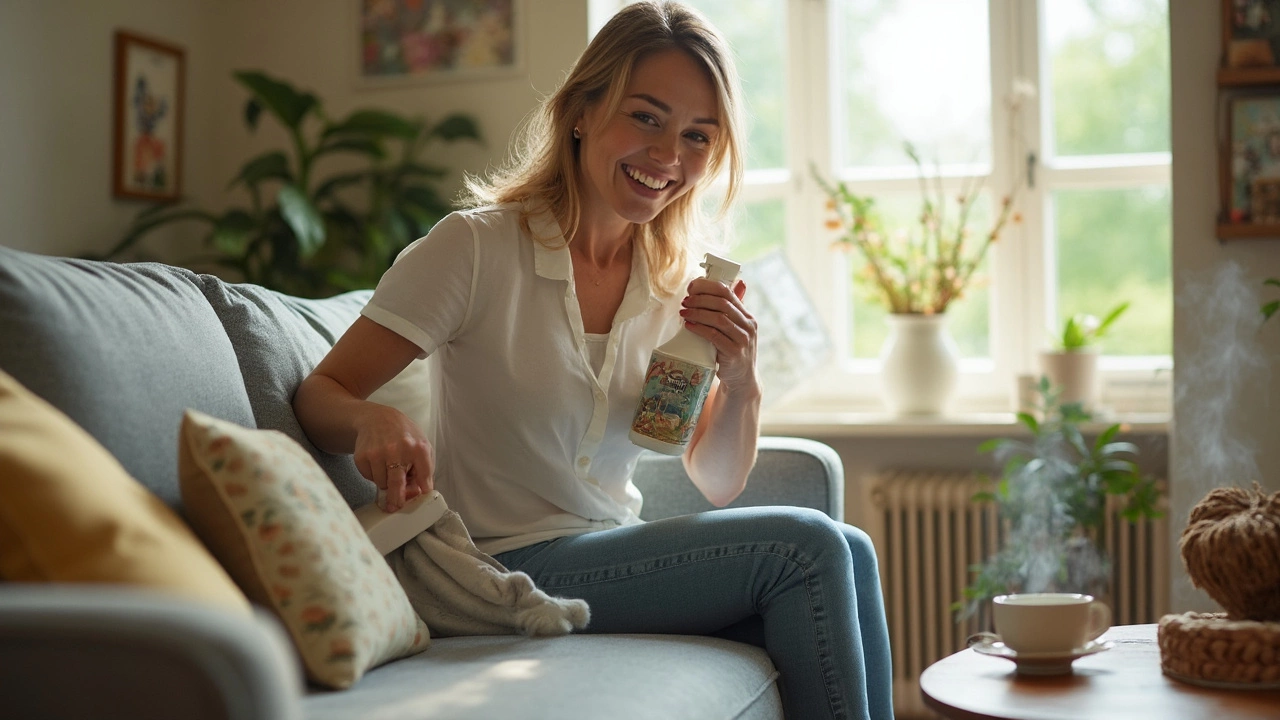Did you know that the average sofa collects more bacteria and allergens than your toilet seat? That’s not even the worst part—your favorite hangout spot might be quietly harboring dust mites, pet hair, crumbs, and the occasional mysterious stain. Now, nobody wants to invite friends over to lounge on a “mystery fabric” sofa. The good news: you don’t need fancy gadgets, a chemistry degree, or a pile of cash to get your upholstery looking and smelling like new again. Cleaning your own furniture saves money and gives you the bragging rights when friends notice your “fresh from the store” look.
Understanding Your Upholstery: What Are You Really Sitting On?
Before you rush into scrubbing, you need to know what you’re dealing with. There’s a wild variety of fabrics out there. We’re talking cotton, polyester, velvet, linen, microfiber, leather, and the hybrids—they all react differently to cleaning products and water. A whopping 70% of modern sofas now mix at least two types of fibers, so don’t just grab the closest bottle of cleaner. Flip over that couch cushion or check under the seat for a tiny fabric tag. It’ll be labeled with codes like “W,” “S,” “WS,” or “X.” Here’s the cheat sheet: “W” means you can use water-based cleaners (lucky you), “S” says stick to solvents only, “WS” means both water and solvent-based are fine, and “X” is a nightmare for DIYers—those usually need nothing but vacuuming.
Ever noticed your allergies flare up in the living room? Your couch could be hiding up to 10 million dust mites, especially if you live somewhere humid. Having pets or kids? Multiply that mess. The American Lung Association warns that soft furnishings trap pet dander and pollen, and most people forget to deep clean them. That means vacuuming isn’t a luxury—it’s a must. Go easy with attachments to avoid damaging the material. Get into the nooks: under cushions, joints, creases, and those weird gaps where remote controls like to play hide and seek.
Sunlight can do a number on upholstery too. Prolonged exposure will fade the fabric and dry out leather. Rotate cushions and rearrange your couch once in a while. If you love the sun streaming in, try window treatments that filter UV rays. Vacuuming once a week is the gold standard for a healthy home, but for high-traffic sofas, twice a week makes a huge difference. Don't ever rub a fresh stain—you’ll push it deeper. Blot first, use a clean white cloth, and always test cleaners on a hidden patch before you go all in. Trust me, you don’t want a big discolored spot in the middle of your seat.
Some fabrics, like wool or silk, are notorious for shrinking or changing color if you get them too wet. If your sofa tag is missing, do a water test: dab a little water somewhere hidden and wait. If it soaks in fast or spreads, it’s water-sensitive—so use dry cleaning tricks. Still not sure? When in doubt, more vacuuming, less liquid. Many folks make the rookie mistake of using way too much water or cleaner; oversaturating the fabric leads to mold, smells, or slow-drying stains. For musty smells, sprinkle a light layer of baking soda, leave it for at least 20 minutes (an hour is even better), and vacuum it up.
Kids and pets bring their own set of stains: crayons, ink, and “mystery goo.” For crayons, scrape off as much as possible, then use a little rubbing alcohol on a cotton swab. For ink, dabbing (not rubbing!) with isopropyl alcohol helps. Sticky messes respond well to ice cubes—harden the sticky stuff, then pry it off with a blunt knife. The right knowledge about your fabric and what it can handle sets you up for real DIY cleaning success. With that, you’ll be ready to tackle grime head-on.

The Step-By-Step Game Plan: DIY Upholstery Cleaning From Prep to Polish
Alright, sleeves up—time to get down to business. Here’s a battle-tested DIY routine that covers everything from casual monthly cleaning to those “yikes, that’s a stain” emergencies. Start with a vacuum cleaner and use its upholstery attachment. Go over the whole piece: arms, seat, back, under the cushions, and even behind the couch. Don’t skip the seams — that’s where crumbs and debris love to hide out.
Next, check the cleaning code and test a small, hidden area using the method you plan on using. Safety first. If all goes well, move to spot cleaning. For most water-friendly upholstery, make a mix: a teaspoon of mild dish soap with a cup of warm water. Dip in a clean cloth, wring it damp (not dripping), then blot the stain. Never rub—let the solution do the work. Once the stain is gone, blot with a cloth dampened in just water to clear leftover soap, then use a towel to absorb excess moisture. You’d be surprised how well this simple formula handles everything from greasy pizza marks to dropped coffee mugs.
If your fabric likes solvents (that’s code “S”), pick up a bit of dry cleaning solvent. Apply using a clean cloth, blot, then give it a quick wipe with a fresh cloth to finish. Still see the stain? Baking soda paste (with just enough water to turn it into a paste) can sometimes do the trick for odors and stubborn spots. Let it sit a while, then vacuum off once dry.
For a deeper whole-sofa clean, go the foam route. You can buy commercial foam upholstery cleaners, or make your own by beating 1/4 cup dish soap into a quart of warm water until you get lots of suds. Scoop the suds with a soft-bristled brush or clean cloth; don’t soak the fabric, just use the foam. Work it into the fabric lightly. When you’re done, wipe away residue with a separate cloth dampened with plain water, and fan or open windows to dry. Some people swear by adding a splash of white vinegar to the rinse water for deodorizing power, but use caution—never go heavy with liquids or you risk that musty couch smell for weeks.
Dealing with pet hair? Run a damp rubber glove over the fabric. The hair sticks right to the glove and comes off much easier than with sticky rollers alone. Got lingering pet odors? A 2024 study found that enzyme cleaners (the same type used for pet accidents on carpets) work well on most synthetic upholstery as long as you don’t soak the surface. Just be gentle—test first, especially if your fabric is cotton or has intricate prints.
Grease stains are a nightmare, yeah? Sprinkle cornstarch on the spot, wait 15 minutes, and vacuum. The cornstarch soaks up the oils, making them much easier to wipe out with soapy water. For blood or wine stains, act fast: blot with cold water, not hot. Heat sets protein stains, which makes them nearly impossible to remove. Using hydrogen peroxide is a last resort; it can bleach fabrics, so only use it on light-colored upholstery and with a patch test.
Here’s a quick all-you-need kit for DIY upholstery cleaning success:
- Gentle dish soap
- White vinegar (optional, for deodorizing)
- Spray bottle
- Plenty of clean white cloths (avoid colored ones—dye can transfer)
- Baking soda
- Soft-bristled brush
- Vacuum with upholstery attachment
- Dry cleaning solvent (for “S” code fabrics)
- Cornstarch (for grease)
- Enzyme cleaner (for pet issues)
- Rubber gloves (for hair removal)
When you finish, leave cushions propped upright and windows open if you can. Good airflow matters—sofas dry faster and you don’t risk that damp stink that lingers for days. And never reassemble or use cushions until they’re completely dry; damp spots hidden inside can take days to show nasty smells or mildew.
Want to keep that sofa fresher for longer? Rotate seat cushions every few weeks. Vacuum under the couch every month. Consider washable slipcovers for family zones—they’re a life-saver if you’ve got little kids or messy pets. And if all else fails, there’s no shame in tossing on a good old throw blanket to cover up last week’s snack disaster while you plan your next big clean.

Long-Term Protection: Keeping Upholstery Fresh and Stain-Free
You’ve put in the work, so how do you stop all that dirt and grime from coming right back? There’s no such thing as a stain-proof sofa (despite what commercials claim), but a few habits can keep your furniture looking Instagram-worthy for way longer. Start with a homemade fabric spray. Mix equal parts water and white vinegar, add a splash of rubbing alcohol, and a few drops of a favorite essential oil. Give the whole sofa a light mist once a week; vinegar fights odors and the alcohol helps it dry faster. Always test it first on a hidden spot, especially if you’re working with delicate fibers.
Avoid eating oily, saucy, or super-crumbly foods on the couch. Even pretzels have a way of finding their way into fabric seams. Train pets to stay off the most delicate pieces, or at least give them their own designated blanket. For high-traffic sofas, invest in a good-quality slipcover--modern stretchy options don’t look half bad and can be machine-washed in case of big messes.
If someone spills, get to it immediately. The longer a stain sits, the harder it is to budge. Blot fresh spills—dab, don’t smear—then use your trusted cleaning mix. Once a season, do a full deep clean. This is when you vacuum, treat stains, and give everything a light freshening spray. Don’t forget to check the base and legs, which collect dust and sticky finger marks, especially if your family includes kids on the move.
Static electricity can make hair and dust cling to upholstery, especially in the winter. Running a dryer sheet over the fabric works wonders to stop the static and release debris—plus, it leaves a clean scent. If your sofa smells musty after deep cleaning, sprinkle more baking soda and let it sit overnight before vacuuming up. For fabrics with a waterproof or stain-resistant finish, avoid harsh cleaners which can strip away the protective layer, making future stains even harder to remove.
Your bed pillows get fresh cases—why not your throw pillows? Wash and change pillow covers every couple of weeks and the inserts every season. Rotate or “fluff” cushions often to avoid permanent dips or creases; this also redistributes wear and makes everything look plumper. Got leather furniture? Wipe it down with a damp soft cloth weekly and treat with a leather conditioner every two months. For faux leather, just a mild soap solution and water does the trick.
Ever heard that sunlight kills dust mites? It’s true—just don’t overdo it. A sunny hour on the porch now and then can keep nasties at bay, but daily direct light will fade color fast. For seasonal changes, do a "furniture shuffle" so tanned-out areas get a break and your favorite perch doesn’t get worn out ahead of the rest of the couch.
The secret ingredient to fresh furniture really isn’t magic—it’s routine. Regular vacuuming, quick spot cleaning, a seasonal deep clean, and rotating pieces around pretty much guarantee your upholstery lasts for years. And if you’re ever in doubt—or facing down a heinous stain—don’t hesitate to call a professional for specialized help. But nine times out of ten, the right DIY tricks will save the day, your pride, and your wallet.
